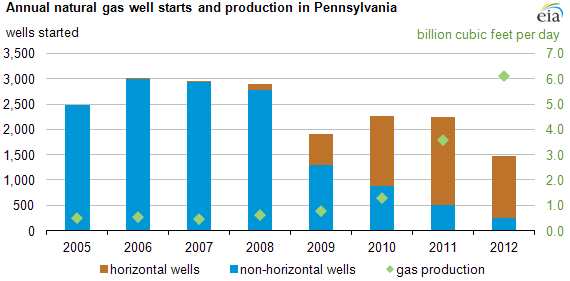
Natural gas production in Pennsylvania averaged 6.1 billion cubic feet per day (Bcf/d) in 2012, up from 3.6 Bcf/d in 2011, according to Pennsylvania Department of Environmental Protection (DEP) data released in February 2013. This 69% increase came in spite of a significant drop in the number of new natural gas wells started during the year.
Several factors contributed to the production increase. While accelerated drilling in recent years (primarily in the Marcellus Shale formation) significantly boosted Pennsylvania's natural gas production, increases were restricted by the state's limited pipeline and processing infrastructure. This created a large backlog of wells that were drilled but not brought online. As infrastructure expanded, these wells were gradually connected to pipelines, sustaining natural gas production increases through 2012 despite the decline in new natural gas well starts. Data from DEP show that a significant portion of wells that began producing in 2012 were drilled earlier.
Improved drilling and well completion techniques can reduce drilling time and lead to higher production per well. The increased use of horizontal drilling (see graph) and hydraulic fracturing, particularly in the more geologically favorable portions of the Marcellus, allows for more production per well. As operators continue to improve well completion techniques, they are achieving higher initial per-well production rates and boosting overall production.
Pennsylvania typically releases major production data twice a year for unconventional (horizontal) oil and natural gas wells and once a year for conventional oil and natural gas wells. (DOE-EIA)
No comments:
Post a Comment